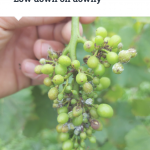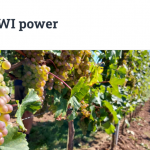Getting ahead of Botrytis
‘Getting ahead of Botrytis’. Vinescape’s Viticulture Director, Joel Jorgensen, shares his wisdom in this article published in the March 2021 issue of Vineyard Magazine.
It lurks in the shadows, invisible, biding its time until conditions are right – then pounces – infecting berries and causing bunch rot. Vineyard finds out why understanding Botrytis cinerea and its modus operandi combined with early season control could save the crop.
When it comes to the control of botrytis bunch rot the timing of the interventions, whether cultural or otherwise are critical to avoiding disappointing losses of yield and quality at harvest.
Botrytis bunch rot, or grey rot, is caused by the fungus Botrytis cinerea. Its spores over winter on the dormant wood, vineyard debris and weeds. It is an opportunist and mostly attacks senescing or damaged tissue and favours wet conditions. In vines, there are really two infection timings – the late infection is obvious, as the berries ripen and are infected where their skins are damaged. The early infection is less obvious and more insidious. Even though symptoms may not show until the fruit starts to ripen many berries will have been infected months earlier and the disease has remained latent. Frustratingly a berry can appear disease-free, only to develop a rot even though the skin is intact.
“The infection sets in during flowering, at cap-fall, this is often misunderstood, but is why control needs to start early. This latent infection is then ready to ‘pounce’ when sugar levels rise and the grape skins thin,” explained Rob Saunders, Agronomist with Hutchinsons.
Cultural practices
Cultural methods involve adjusting the vine’s immediate environment to make it less attractive to botrytis. “Humid, still, air promotes the disease, so make sure there are no overhanging trees or dead air pockets in the vineyard, keep the canopy open and leaf strip when necessary to ensure air movement and rapid drying in the canopy,” added Rob Saunders.
“There are many methods for controlling botrytis, but prevention is better than cure,” explains Emma Bridge, Viticulturist ‘Vignette’ at Fox & Fox, in Sussex. “Build in preventative measures as part of your Integrated Pest Management (IPM) practice – but still give yourself the option of any tool in the toolbox as a last resort,” she added.
Last year’s season impacts this year, “so if there is fruit left on the vines after harvest, take it off as soon as possible. Botrytis isn’t a strong pathogen – but it’s highly efficient once it gets stuck in. If you’ve got inoculum hanging around, it’ll spread once it gets the chance, so limit its chances. Canopy management allows hygiene to do so much work for you. Air flow and ultra-violet light discourage fungal growth – so that won’t just help your botrytis control, it will help with mildews too. I am far too lazy to want to do things badly if it will generate extra work late – so do it right first. I can be quite outstandingly boring on the significance of the V in VSP (Vertical Shoot Position). If your shoots are vertical, the air flow is better, the light penetration is better, the shoots get to the top wire sooner so you can get on with trimming and pushing development into the fruit. Also
– your spray penetration and efficacy are improved, because your target zone is where you expect it to be,” explained Emma.
Cultural practices are particularly important in the management of organic and biodynamic vineyards. Alex Valsecchi, Viticulture Consultant and Vineyard Manager at Albury Organic Vineyard, in Surrey, explains that she uses: “Leaf removal on the east side of the rows at fruit set, so that the exposure and air movement can help to dry out the flower caps but not too early as you don’t want to interrupt pollination. Later we may do some light leaf removal on the western side, especially if it is a damp season.”
According to Joel Jorgensen, Viticulturist and Veraison MD: “As with all things fungal, botrytis control starts with good, calculated, canopy management throughout the season. Maximum sunlight penetration and moderate airflow goes a long way. Balanced plant nutrition pre-flowering, particularly boron, is important for enabling good fruit set – along with good weather of course – and thorough cap-fall. This minimises the amount of debris left inside the young bunches before bunch closure – which could get infected and cause bunch rot from the inside. A little trick for removing any stuck caps and debris is to run your sprayer fan (water in the tank, nozzles switched off) on max and target the air at the bunch zone, be careful with timing and pressure though as you don’t want to damage your flowers or bruise the berries.”
With many vineyards starting to trail some of the new fungus resistant vine varieties (PIWI), the next few years should provide some interesting results to compare the incidence of diseases, including botrytis. Will Mower, Vineyard Manager with Vine Works, has a few different PIWI varieties at their Bee Tree vineyard. “They do appear to have an inherent resistance to fungal diseases, and I have noticed that when other varieties around have some powdery mildew they remain clean and seem less susceptible. Without the damage from the powdery mildew they do not get botrytis. However, I think if there was bird or wasp damage, botrytis would occur,” he said.
Monitoring and identification
As the botrytis spores remain latent until conditions are favourable, monitoring and identification is more challenging. Sustainable Wines of Great Britain, WineGB’s sustainability scheme, publishes regular bulletins with guidelines for its members. According to the recent bulletin on IPM, a way of identifying botrytis is to collect bunch residues, flower clusters and bunches, and seal samples in plastic bags. Leave these at room temperature (20°C) for 1 – 3 days, then look for the growth of grey-brown mould. The key sampling times are when shoots are 10 – 15 cm long, early flowering, veraison, two weeks before harvest and at harvest time.
Alex Valsecchi checks her crop regularly: “I remove damaged berries or bunches, which can happen during trimming – or even by the pheasants – as the damaged tissue is where the flare-ups occur. Early signs are a change in berry colour, or a softening – then you know something is up.”
Joel Jorgensen also advises: “Walk your crops as often as you can and consult your agronomist immediately if you spot any signs of primary infection. Remember that there is no recipe for disease control so be sure to adjust the spray programme as the season progresses.”
Biological control agents
Considered more sustainable than conventional products, biological control agents (BCA) are being increasingly used, and with good results reported.
Rob Saunders recommends the use of BCAs, particularly close to harvest. “It’s best to use biocontrol agents such as Amylo-X and Botector, especially if the season is damp. Also Karma (Potassium Bicarbonate) can be considered as it is alkaline and shifts the pH on the surface of the tissue and the crystals interfere with fungal mycelial growth,” he said.
Organic and biodynamic growers, such as Alex from Albury, use a multi-pronged approach combining cultural, biological control and more traditional products. Alex explains: “We mainly use Bacillus Subtilis for control of botrytis. Our first spray is when flowering is 50% to 80% underway, the second spray pre-bunch closure, the third at veraison and the fourth just pre-harvest, as it has no harvest interval. In between these applications we use sulphur for powdery mildew, but it also provides some control of botrytis. Apart from a couple of extremely wet years, such as 2012, we hardly have any botrytis – except for the Seyval Blanc. It seems more prone to botrytis due to its tight bunches and thinner skins. We can also use potassium bicarbonate to help dry out the crop, if the berries are starting to get a bit – my technical term – squishy squashy!”
Joel Jorgensen comments: “There are some great new products out there showing some promising results. One example of a product I’m keen to trial this year is based on Cerevisane, a purified extract of a Saccharomyces cerevisae (brewer’s yeast). ‘Romeo’ mimics a disease attack on the plant and acts to strengthen the plant resistance – a bit like the flu jab. Another is a Bacillus amyloliquefaciens strain where the principal modes of action are colonisation and competition on the plant surface against pathogens, release of antimicrobial metabolites and inducing systemic resistance in the plant.”
The spray programme
Starting early is the key, explains Joel Jorgenson: “I aim to get my first botrytis sprays on pre- bunch closure to ensure the bunches are protected from the inside. Targeted and well-timed leaf removal is essential for maximising penetration all the way to the rachis. Missing this spray will leave you on the back foot for the rest of the season. I then generally include a preventative every 14 days until harvest.”
Agronomist, Rob Saunders said: “I recommend to growers to apply Switch early in flowering, but then use Scala during early berry development, as this can move through plant tissue and cleans up latent infection. This has been shown to measurably decrease laccase levels in juice (which is good as laccase is an undesirable enzyme produced by botrytis). Then I encourage growers to apply Teldor at bunch closure – as once the bunch is closed it’s too late to get coverage. The BCA’s come into their own between bunch closure and harvest”.
.






